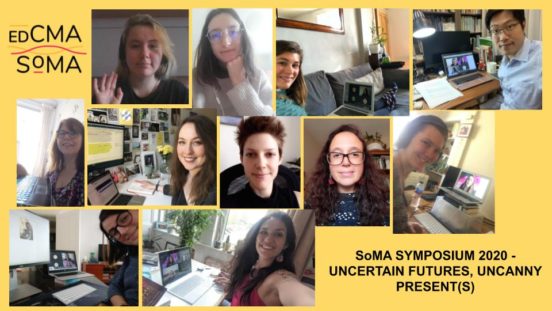On 27 April 2020, the Students of Medical Anthropology (SoMA), a student-body subgroup of the Edinburgh Centre for Medical Anthropology (EdCMA), held their annual Symposium virtually. This year’s symposium was entitled ‘Uncertain Futures, Uncanny Present(s)” and was divided into two sections: what the covid-19 pandemic reveals and what the covid-19 obfuscates. The call for papers was open to postgraduate students and early career researchers regardless of university and discipline, and encouraged think pieces, works-in-progress, or completed articles discussing the impact of covid-19 on their research. Students from various British universities attended as speakers and audience members.
The Symposium highlighted how covid-19 is transforming PhD research in wide-ranging fields, regardless of academic focus or geographic locality. More importantly, however, the Symposium revealed the creativity, adaptability, and re-imagining made possible by the PhD researchers. In the concluding remarks, the participants brainstormed together that the overarching themes of the presentations demonstrated:
- Even disruption and absence can be data. Paying attention to these moments of interruption is important.
- The importance of resisting the naturalising of responses to the pandemic. These are not automatic responses; they are political. Anthropology is well-placed to highlight and explore this resistance.
- Covid-19 has dismantled the division of a researcher’s ‘home’ from a researcher’s ‘field’. Research at the moment is beyond anthropology at home.
The Symposium further served to provide some normalcy during the lockdown, offering students the opportunity to network, receive feedback on their work, and re-experience a conference setting at a time when academic life is disrupted.
Overview of papers
‘Reveal’
- The wisdom of Lyme disease patients – Ritti Soncco
- Healthcare in Bangladesh – Janet Perkins
- Social distancing in India – Jordan Mullard
- Healthcare in Taiwan – Yi-Cheng Wu
- Abortion pills access in the UK – Leah Eades
‘obfuscate’
- Military metaphors in Covid-19 – Iona Walker
- Houses as public health technology – Imogen Bevan
- Re-imagining death – Tara Pollak
- A world without touch – Andrea Lambell
- Hospitals as environments in suspension – Cristina Moreno Lozano
Summary of the Presentations
Ritti Soncco (University of Edinburgh) conceptualised that in this new world created by covid-19, those holding a torch and a map are people who have lived with chronic illnesses for years. Her interlocutors, people living with Lyme disease in Scotland, reacted with familiarity and preparedness to the lockdown, stockpiling and social distancing, enabled by years of experience due to their chronic illness. She explored her theory that these new and frightening ‘states of pandemic’ are, to the chronically ill, continued ‘states of normality’. In this world, nothing has really changed. This highlighted that the panic and fear many people felt at the start of the pandemic is a panic and fear Lyme disease patients have lived with for years. Her paper then elaborated on the lessons and advice her interlocutors gave to prepare the public for lockdown, concluding that now is an important time to remake visible those made invisible by their illnesses. Her paper is available here.
Janet Perkins (University of Edinburgh) described how covid-19 has highlighted the fragmentation and weakness in both the private and public health sectors in Bangladesh. Social distancing is a hard product to ‘sell’, where the ‘self’ begins with ‘the family’ and a crowd is more cosy than suffocating. Rather than a social good, healthcare is conceived akin to ‘charity’. The private sector, unregulated by the state, has the luxury of deciding if and when it would engage in the battle with covid-19. Some closed their doors; others rented out their beds to the elite in case these become sick. Until then, the beds remain empty. Perkins’ research concluded to explore how covid-19 revealed who could access healthcare and who couldn’t, as well as who was on the frontline – and who could opt out.
Jordan Mullard (University of Durham) questioned what it means to be ‘socially distant’ in India, describing two forms: vertical and horizontal. Vertical social distancing has been present for a long time in the form of caste and class. Horizontal social distancing, the harder one to enforce, takes place among people within the same group. The attempts to enforce social distancing as a duty have revealed that social distancing is a luxury because to be near is a necessity. She further questioned what duty means in a setting where solidarity, resistance and resilience are created through nearness. What are the associated moralities with this? Mullard argued that for this, it is important to engage simultaneously with moral anthropology and the anthropology of moralities, in order to explore duty, kinship, mutuality and responsibility. She concluded with the question: “Is duty to shame what guilt might be responsibility?” This paper is a work-in-progress with an upcoming publication.
Yi-Cheng Wu (University of Durham) is currently witnessing covid-19 as a doctor in Taiwan and deconstructed what has been called Taiwan’s ‘advanced deployment’ strategy. His paper argued that war politics are never easy to measure, depicting how patriotic symbolism prevail and government officials are celebrated as ‘national heroes’. Expanding upon Taiwan’s medical strategy, Wu described medical staff as aggressive resisters of strategies, highlighting their demands for upgrades. Such upgrades, Wu exemplified, are thermal cameras at hospital entrances, and insurance cards which record a patient’s travel history data and can be read in card readers. Wu argued that the logic of ‘advanced deployment’ reveals Taiwan’s struggle for international recognition.
Leah Eades (University of Edinburgh) opened with an international overview of abortion in the era of Covid-19, from Argentina to Poland. She described how some countries had attempted to implement stronger anti-abortion measures, using the lockdown as a means to bypass public protests, or by proclaiming abortions ‘non-essential’ elective procedures. Focusing then on England, Scotland and Wales (where the 1967 Abortion Act applies), she described the recent introduction of telemedicine abortion. In Northern Ireland, however, the government argued it did not have the resources to begin providing abortion services during the pandemic, stating women would need to travel to England for abortions in spite of the lockdown; following a 10-day standoff, the government now offers abortions in clinics, although not remotely as in the rest of the UK. Eades argued that Covid-19 has revealed a major reconfiguration of abortion access, with infrastructures affecting who can and who cannot access abortions of various kinds during this time. Equally, while medication abortion provides many opportunities, it is not available or appropriate to all. Eades concluded that the crisis reveals both the possibilities and shortcomings of abortion pills and a need to address the broader structural issues in which they are used.
Iona Walker (University of Edinburgh) asked in a more-than-human-world, what are the consequences of military language in response to threats of contagion and how do these differ for slow and quick crises? Walker explored covid-19 as a ‘fast’ crisis with military language transforming the social, political and material world of hospitals as warzones, masks as protective armour and political offices as war rooms – contrasting this with AMR as a ‘slow burn’ with consequences for shaping the movement of resources for an ‘arms race again bacteria’ and imagining bodily landscapes of fortress against superbugs. Her upcoming research seeks to understand the limits, possibilities and consequences of military language for human and microbial relationships and how these might be imagined differently.
Imogen Bevan (University of Edinburgh) deconstructed the NHS campaign ‘Stay Home, Stay Safe’ in her presentation. In Britain, home confinement seems to provoke little controversy, understood as a sacrifice willingly made in times of pandemic. Bio-surveillance technologies on the other hand provoke profound moral discomfort. Why is this? Isn’t the house also a technology of sorts? What is being expected of the house? And what might houses in times of covid-19 reveal about social relationships and values in contemporary Britain? Reflecting on past public health interventions on and through the house, Bevan’s talk explored the implications of rethinking houses as a public health technology of preparedness.
Tara Pollak (University of Edinburgh), whose PhD research is about pregnancy loss, used her paper to explore death during covid-19. She considered the narrative of ‘heroic death’ in relation to NHS workers, in contrast to ‘neglected narratives’ of deaths not reported, e.g., due to cancelled surgeries, reduced services, accidents or age. She explored the new productions around managing death, from the disruption of social and emotional networks to altered emotional labour of bereavement, asking how these deaths will be remembered and understood after the pandemic is over. “Death itself has become viral”, Pollak argued, concluding to ask: Will the current situation result in a memorialisation of essential workers? What are the socio-political implications of such memorialisation? Are we going to re-think how we report deaths in public health statistics and make sense of such numbers in emotionally intelligent ways? Are we going to talk about funeral poverty and the ways in which people relate to the dead socially, spiritually, materially?
Andrea Lambell (University of Durham) had planned her fieldwork around massage ethnography in palliative care – but in the world created by covid-19, ‘touch has become the thing we all crave and the thing we all fear at the same time’. As she cannot currently conduct fieldwork, Lambell has shifted her focus to explore what is hidden when touch is taken out of the communication repertoire of palliative care. ‘Covid has taken away my toolkit, it has taken away from all massage and touch therapists,’ she states. How will this gap be bridged? How do we reach out to people who are hidden, dying on their own? ‘If we are afraid of touch or becoming close physically to people, we as friends, family, neighbours, will struggle further to give end-of-life care,’ Lambell argued. Her new project will thereby explore non-verbal, non-tactile communication and how the loss of touch obscures communication.
Cristina Moreno Lozano (University of Edinburgh) discussed how antibiotic stewardship programmes in hospitals and the problem of antimicrobial resistance (AMR) have been interrupted. Healthcare workers can think of nothing other than covid-19, they are exhausted and have worked heavy shifts for over 50 days by now. She argued for a perception of hospitals as more than buildings: they are enclosed environments, habitats, containing infrastructures, relationships, and technologies all at once, where microbial-human relationships are experienced and governed. Her paper was dedicated to the La Paz Hospital in Madrid, one of the most heavily transformed hospitals in Madrid to treat covid-19 patients in the past weeks. As an iconic feature, it represents a familiar skyline, reflections of privatisation and austerity, and unkept promises. The photographs she shared highlighted the hospital as a space/place which produces social value and mobilised affects, much as Alice Street, Janina Kehr or Fanny Chabrol have shown in their hospital ethnographies. Hospitals during the covid-19 pandemic are an enclosed environment where – resistant or non-resistant microbes, affected technology, care, experience and control relate to each other. All these things, argued Moreno, were already there before covid-19. What has changed is that covid-19 has put her project, antimicrobial stewardship programmes, and the La Paz Hospital into suspension, and now we can somewhat see what these hospitals ‘contain’ in greater detail.










Comments by Ritti Soncco